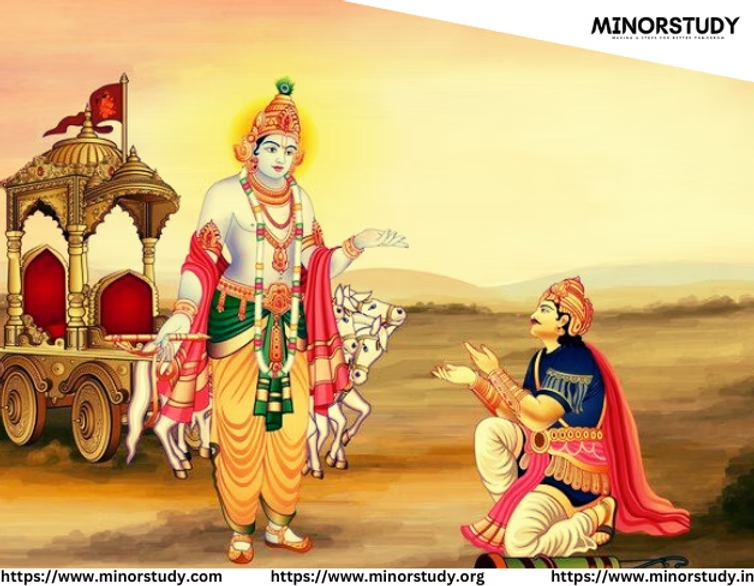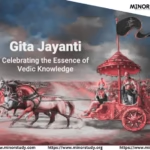The Bhagavad Gita: An Overview
The Bhagavad Gita, often referred to simply as the Gita, is a 700-verse scripture that is part of the Indian epic Mahabharata. It is a spiritual and philosophical dialogue between Lord Krishna and Prince Arjuna that takes place on the battlefield of Kurukshetra. The Gita is a cornerstone of Hindu philosophy and spirituality and has influenced thinkers, leaders, and spiritual seekers around the world.
Key Themes of the Bhagavad Gita
Dharma (Duty): The Gita emphasizes the importance of fulfilling one’s responsibilities and duties with sincerity and righteousness.
Karma (Action): It advocates for selfless action without attachment to the fruits of one’s efforts (Karma Yoga).
Jnana (Knowledge): The pursuit of spiritual knowledge and self-realization (Jnana Yoga) is emphasized as a path to liberation.
Bhakti (Devotion): Total surrender and devotion to God (Bhakti Yoga) is presented as a means to attain spiritual fulfillment.
Equanimity: Maintaining balance and calmness in success and failure, joy and sorrow, is a central teaching.
Self-Realization: Understanding the eternal soul (Atman) and its connection to the universal spirit (Brahman).
Structure of the Bhagavad Gita
The Gita is divided into 18 chapters, each focusing on different aspects of life, duty, and spirituality:
Chapter | Focus |
1. Arjuna Vishada Yoga | The Dilemma of Arjuna |
2. Sankhya Yoga | The Path of Knowledge |
3. Karma Yoga | The Path of Action |
4. Jnana Yoga | Knowledge and Wisdom |
5. Karma Vairagya Yoga | Renunciation and Detachment |
6. Dhyana Yoga | Meditation and Self-Discipline |
7. Jnana Vijnana Yoga | Knowledge of the Ultimate Reality |
8. Akshara Brahma Yoga | The Eternal Imperishable |
9. Raja Vidya Raja Guhya Yoga | The Royal Knowledge and Mystery |
10. Vibhuti Yoga | Divine Glories of the Absolute |
11. Vishwarupa Darshana Yoga | The Vision of the Universal Form |
12. Bhakti Yoga | The Path of Devotion |
13. Kshetra Kshetrajna Vibhaga Yoga | The Field and the Knower of the Field |
14. Gunatraya Vibhaga Yoga | The Three Modes of Nature |
15. Purushottama Yoga | The Supreme Person |
16. Daivasura Sampad Vibhaga Yoga | Divine and Demonic Qualities |
17. Shraddhatraya Vibhaga Yoga | The Threefold Faith |
18. Moksha Sannyasa Yoga | Liberation and Renunciation |
Significance of the Bhagavad Gita
Spiritual Enlightenment: Provides insights into life, self-realization, and the nature of the universe.
Practical Guidance: Offers solutions for daily life challenges through its emphasis on duty, detachment, and devotion.
Universal Relevance: Its teachings transcend religious and cultural boundaries, making it relevant for people from all walks of life.
Philosophical Depth: Explores profound concepts like the nature of the self, consciousness, and liberation.
Inspiration for Leadership: Leaders like Mahatma Gandhi and Swami Vivekananda drew inspiration from the Gita.
Core Teachings of the Bhagavad Gita
Focus on Action: “You have the right to perform your duties, but not to the results thereof.” (Karma Yoga)
Self-Realization: The soul is eternal, unchanging, and beyond the physical body.
Devotion to God: Surrendering to God with pure love and faith leads to liberation.
Balance and Equanimity: Be unaffected by success and failure, pleasure and pain.
Unity in Diversity: Recognize the oneness of all beings and the universal spirit.
Relevance of the Bhagavad Gita Today
In Personal Life: Teaches stress management, ethical living, and inner peace.
In Leadership: Guides decision-making and inspires selfless leadership.
In Modern Philosophy: Offers a framework for understanding life’s purpose and tackling existential questions.
In Education: Encourages lifelong learning and self-discovery.
Famous Quotes from the Bhagavad Gita
“You have the right to perform your duties but are not entitled to the fruits of your actions.”(Chapter 2, Verse 47)
“When meditation is mastered, the mind is unwavering like the flame of a lamp in a windless place.”(Chapter 6, Verse 19)
“I am the beginning, middle, and end of creation.”(Chapter 10, Verse 20)
“A person is considered superior who is impartial to friends, enemies, relatives, and strangers.”(Chapter 6, Verse 9)
Wishes and Blessings on Gita Jayanti
“May the teachings of the Bhagavad Gita guide you to a life of righteousness, peace, and enlightenment.”
“On this sacred day, may the wisdom of the Gita inspire you to lead a purposeful and devoted life.”
“Embrace the divine teachings of the Gita to discover your inner strength and achieve spiritual liberation.”
Conclusion
The Bhagavad Gita is more than a scripture; it is a guide to life’s challenges and a source of timeless wisdom. Its teachings on duty, selflessness, and devotion remain relevant and inspiring, offering practical solutions to modern-day dilemmas while leading individuals toward self-realization and inner peace.








